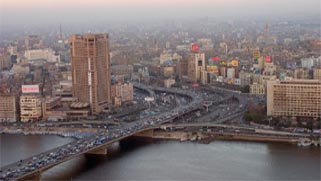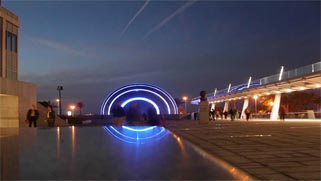|
|

| |
| |
Karnak Temple
|
| |
Where today thousands of tourists stand in awestruck
silence at Karnak’s gargantuan architecture there once
beat the religious heart of ancient Egypt. The entire
temple complex was formed from three independent
precincts, each of which was enclosed by walls of
unfired mud bricks. At the center lay the gigantic Amun
temple which covered an area of well over 100 ha (247
acres). It was adjoined immediately to the north by the
smaller precinct of Month, the old local deity of
Thebes.
The other neighboring temple of the goddess Mut was
built to the south of Amun temple, and the two were
connected by an avenue of sphinxes. The network of
processional roads on the Theban east bank alone covered
several miles and was flanked by almost 1300 statues of
sphinxes. Archeologists have shown that Karnak’s 2000
year architectural history began in the early Middle
Kingdom and stretched into the Greco-Roman period. Its
intrinsic scale was established by the enormous building
programs initiated by the monarchs of the New Kingdom.
Almost all the pharaohs of this era left their mark on
the imperial temple of Amun in order to honor their
divine father Amun-Re, “King of the Gods.” The complex
has two axes, the main one running in an east-west
direction from the inner sanctum to the first pylon. The
side axis, the cult route to the precinct of Mut, starts
at the fourth pylon and runs south through pylons seven
to ten with their courtyards.
Within the walls of the Amun precinct stands a series of
other shrines and chapels including a temple for the
moon god Khonsu from the Twentieth/Twenty-first
Dynasties and the small temple to Ptah at the northern
enclosure wall whose core was built during the reign of
Thutmosis III. The same king built a temple for the sun
cult directly outside the eastern enclosure wall of the
main temple; a single obelisk (H. 101 ft, 30.7 m) stood
at its center but since 1587 this has decorated the St
John in Lateran Square in Rome. The continual expansion
of the Amun temple necessarily meant the demolition of
older buildings.
The stone from these buildings was then recycled (see p.
329) and provides the basis for our knowledge of temples
in the Middle Kingdom and early Eighteenth Dynasty;
these include such shining examples of architecture as
Senusret I’s “White Chapel” and the great barque shrine
of Hatshepsut, the “Red Chapel.” Ever since Auguste
Mariette excavated at Karnak in 1858 investigations at
the site have largely been carried out by French
scholars. Responsibility for the main archaeological
work and conservation effort has been exercised by the
Centre Franco-Egyptian since 1967. |
| |
| |
| |
|
| |
|
The Great
Hypostyle Hall in Karnak |
|
| |
Painted lithography from David Roberts’ “Egypt and
Nubia,” London 1846-1850 Pictures from the 19th century
record how the Great Hypostyle Hall then looked with its
growing piles of rubble, toppled columns and collapsed
architraves.
Extensive damage to the foundations finally led to the
deafening collapse of this famous building on October 3,
1899. Decades were to pass before it was reconstructed. |
 
|
| |
| |
| |
: |
Ram
sphinxes at the first pylon |
|
| |
Nineteenth Dynasty, ca. 1250 B.C.
The architectural history of the Amun temple began with
a building by Senusret I in the courtyard of the Middle
Kingdom (now destroyed) before advancing west-wards. The
first pylon, dating from the Thirtieth Dynasty, was the
last monumental structure (W. 370 ft, 113 m) to be built
along this axis although it was never completed. The
largest gateway ever built, this pylon interrupted a
long avenue of sphinxes which originally led from the
second pylon of Horemheb to the quay of the temple (with
its great harbor basin and canal connecting it to the
Nile) and which was probably laid out under Ramesses II.
Mounted on high pedestals on both sodes of the cobbled
processional avenue are the figures of so-called cryos
sphinxes combining the body of a lion with the head of a
ram, the sacred animal of Amun. Royal statuettes held
between the paws of each sphinx symbolize the favor and
protection shown by the god.
|
 
|
| |
|
|
Colossal
figure at the second pylon |
|
| |
Nineteenth Dynasty, ca. 1250 B.C.
The great courtyard behind the first pylon (south tower
with remains of the brick construction ramp) is occupied
by a number of buildings from a variety of eras. The
center is dominated by the gigantic pillared kiosk of
King Teharqo of the Twenty-fifth Dynasty. Of the ten 69
ft (21 m) high papyrus columns which supported this
structure, only one still stands. It must have been at
the time of this construction work that the avenue of
sphinxes was blocked off and the individual figures at
the sides of the courtyard were put in storage.
This courtyard was constructed during the Twenty-second
Dynasty under Sheshonq I when the area in front of the
second pylon was enclosed by a colonnade.
Behind the north tower of the first pylon is the
tripartite barque shrine of Sety II while the temple of
Ramesses III is integrated into the ensemble on the
southern side of the courtyard and at right angles to
the main axis. A colossal standing figure (H. 36 ft, 11
m) in red granite has been re-erected at the gate of the
second pylon; its fragments were discovered in 1954. The
king is shown wearing a headdress with the double crown
and a short loincloth. His hands, crossed on his chest,
hold the crook and flail of his office; a small figure
of a queen stands at his feet. Although the inscriptions
indicate the owner as being the priest-king Pinudjem I
(Twenty-first Dynasty) the colossus may well have been
carved in the Ramesside era. |
 
|
| |
| |
| |
 |
The
Karnak Temple
In ancient Egypt, the power of the god Amun of Thebes gradually increased during the early New Kingdom, and after the short persecution led by Akhenaten, it rose to its apex. In the reign of
Ramses III, |
 |
|
|
|
 |
The Valley of the Kings
The tombs of the
Valley of the Kings originally contained many other
items that were transferred to the Egyptian Museum
like the royal belongings of the king that he will
use in the afterlife |
 |
|
| |
 |
The Queen Hatshepsut Temple
In a spot sacred to the goddess Hathor in the West Bank of Luxor, situated under the foot of one of the huge Theban Mountains, the Queen Hatshepsut has built her mortuary temple that was so fascinating that was called many names in ancient times |
 |
|
| |
 |
The colossi of Memnon
The Colossi of Memnon. One of the main attractions on the West Bank of Luxor, a landmark which everyone passes on the road to the monument |
 |
|
| |
 |
The
Luxor Temple
Located in the heart of the modern city of Luxor, the Luxor temple, especially the two colossi of Ramses II situated at the entrance of the temple, has become a land mark of the city. |
 |
|
|
| |
 |
 |
 |
 |
 |
 |
 |
Discover Luxor
Do you have plans to travel to Egypt?
A comprehensive Egypt travel offer – of every type, destination and period in Egypt! In addition, |
Luxor Attractions
Luxor attractions and sightseeing attractions in
Luxor . Book Luxor attraction tours
with Select Egypt |
Luxor Holidays
special discount holiday packages offers for
Luxor travel. We give you tailor made holiday deals for
Luxor travel |
Luxor Tours & Excursions
special discount holiday packages offers for
Luxor excursions. We give you tailor made holiday deals for
Luxor travel |
| Read More >> |
Read More >> |
Read More >> |
Read More >> |
|
| |
 |
| |
 |
 |
 |
 |
 |
Luxor Hotels
Choose from over 89
Luxor hotels with huge savings. Whatever your budget, compare prices and read reviews for all our
Luxor hotels |
Luxor Map
Luxor was constructed on the ruins of the ancient city of Thebes, the capital of Egypt during the Pharaonic New Kingdom (1550 – 1069 BC). |
Luxor Monuments
The best monuments of
Luxor . Information about Luxor monuments, landmarks, historic buildings and museums in
Luxor |
| Read More >> |
Read More >> |
Read More >> |
|
| |
|
|
|